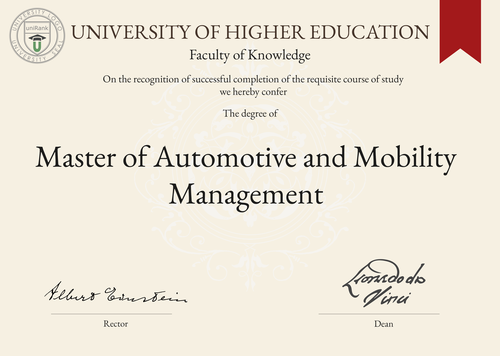
Master of Automotive and Mobility Management (MAMM)
Guide to Master of Automotive and Mobility Management Program/Course/Degree
Master of Automotive and Mobility Management (MAMM)

Program Name
Master of Automotive and Mobility ManagementProgram or Degree abbreviation
MAMMDuration range
The duration of the program can vary depending on the country or university, typically ranging from 1 to 2 years.Tuition range
The tuition fees for the program can vary depending on the country or university, typically ranging from $10,000 to $30,000 per year.Overview
The Master of Automotive and Mobility Management program is designed to provide students with a comprehensive understanding of the automotive industry and its evolving mobility landscape. It equips students with the necessary skills and knowledge to navigate the challenges and opportunities in this rapidly changing field.Curriculum Overview by year
The curriculum is structured to cover various aspects of automotive and mobility management. In the first year, students typically study core courses such as Automotive Industry Analysis, Mobility Trends, Supply Chain Management and Marketing Strategies. In the second year, students can choose elective courses based on their interests and career goals, which may include topics like Electric Vehicles, Autonomous Driving and Sustainable Mobility Solutions.Key Components
The key components of the program include gaining a deep understanding of the automotive industry, exploring emerging mobility trends, developing skills in supply chain management and marketing strategies and gaining expertise in specific areas such as electric vehicles and autonomous driving.Career Prospects
Graduates of the Master of Automotive and Mobility Management program can pursue various career paths in the automotive and mobility industry. They can work in roles such as automotive product managers, mobility consultants, supply chain managers, marketing executives and sustainability specialists.Salary Expectations
The salary expectations for graduates of the program can vary depending on factors such as the country, industry and job role. On average, professionals in the automotive and mobility management field can earn salaries ranging from $50,000 to $100,000 per year. For a more accurate understanding of salary expectations, you can utilize the Job Sites Search Engine, from our sister site jobRank, which searches over 4,600 job sites worldwide. Make sure to specify not only the job title but also the country you are interested in.Conclusions:
It is important to note that the duration, tuition fees, curriculum, key components, career prospects and salary expectations of the Master of Automotive and Mobility Management program can vary depending on the chosen country or location of study, as well as the chosen university. Visitors interested in pursuing this degree are encouraged to use the uniRank World Universities Search Engine to find institutions offering this program worldwide.World Universities Search Engine
search for Master of Automotive and Mobility Management (MAMM) and add the Location (country, state etc.) or specific University you are interested in studying at.
Query examples:
- Master of Automotive and Mobility Management (MAMM) United States
- Master of Automotive and Mobility Management (MAMM) United Kingdom online
- Master of Automotive and Mobility Management (MAMM) Australia international students
- Master of Automotive and Mobility Management (MAMM) University of California
- Master of Automotive and Mobility Management (MAMM) University of London tuition fees
- Master of Automotive and Mobility Management (MAMM) University of Sydney scholarships
Share Program/Course
Interesting? Share this program/course/degree info with your friends now.